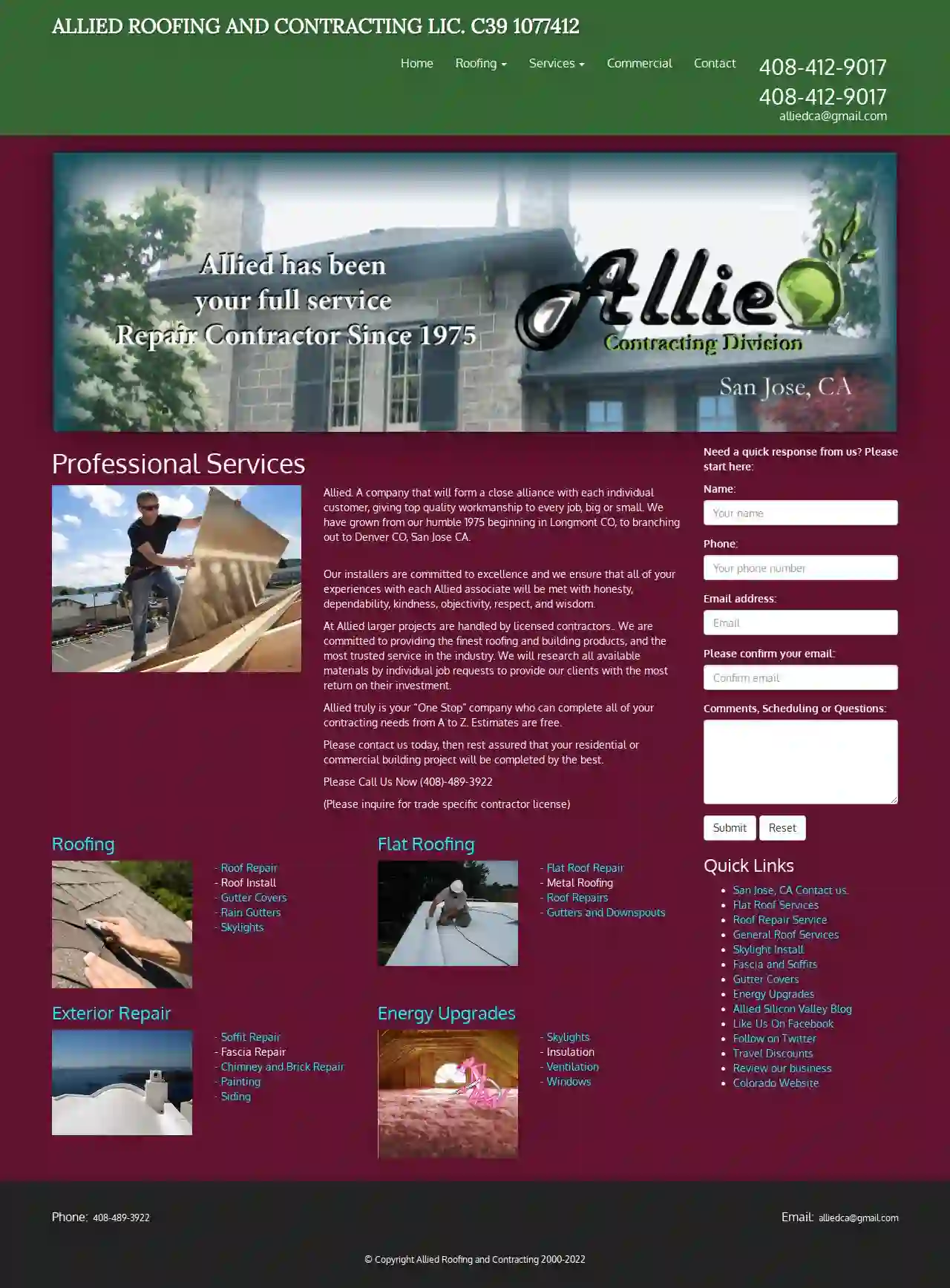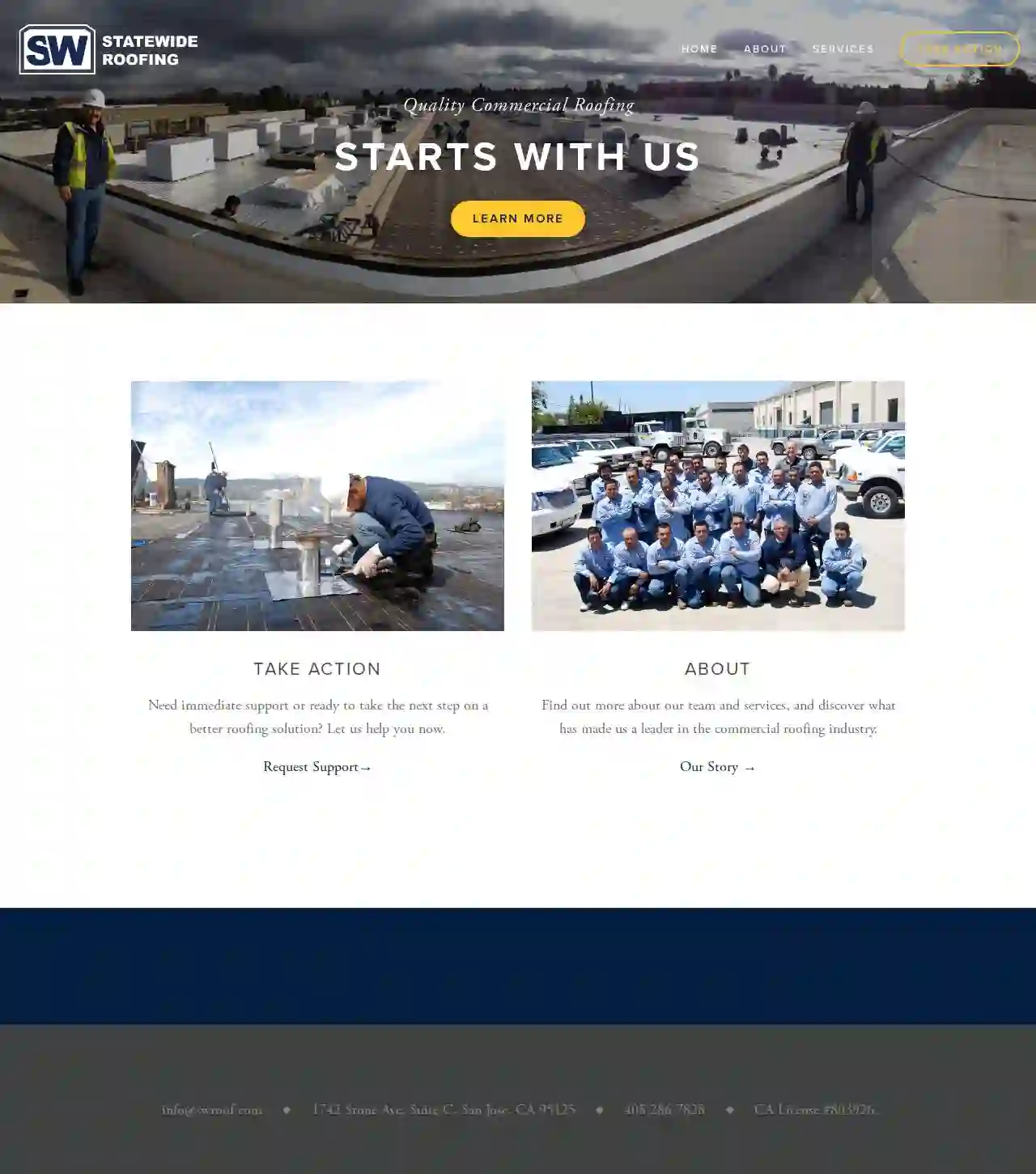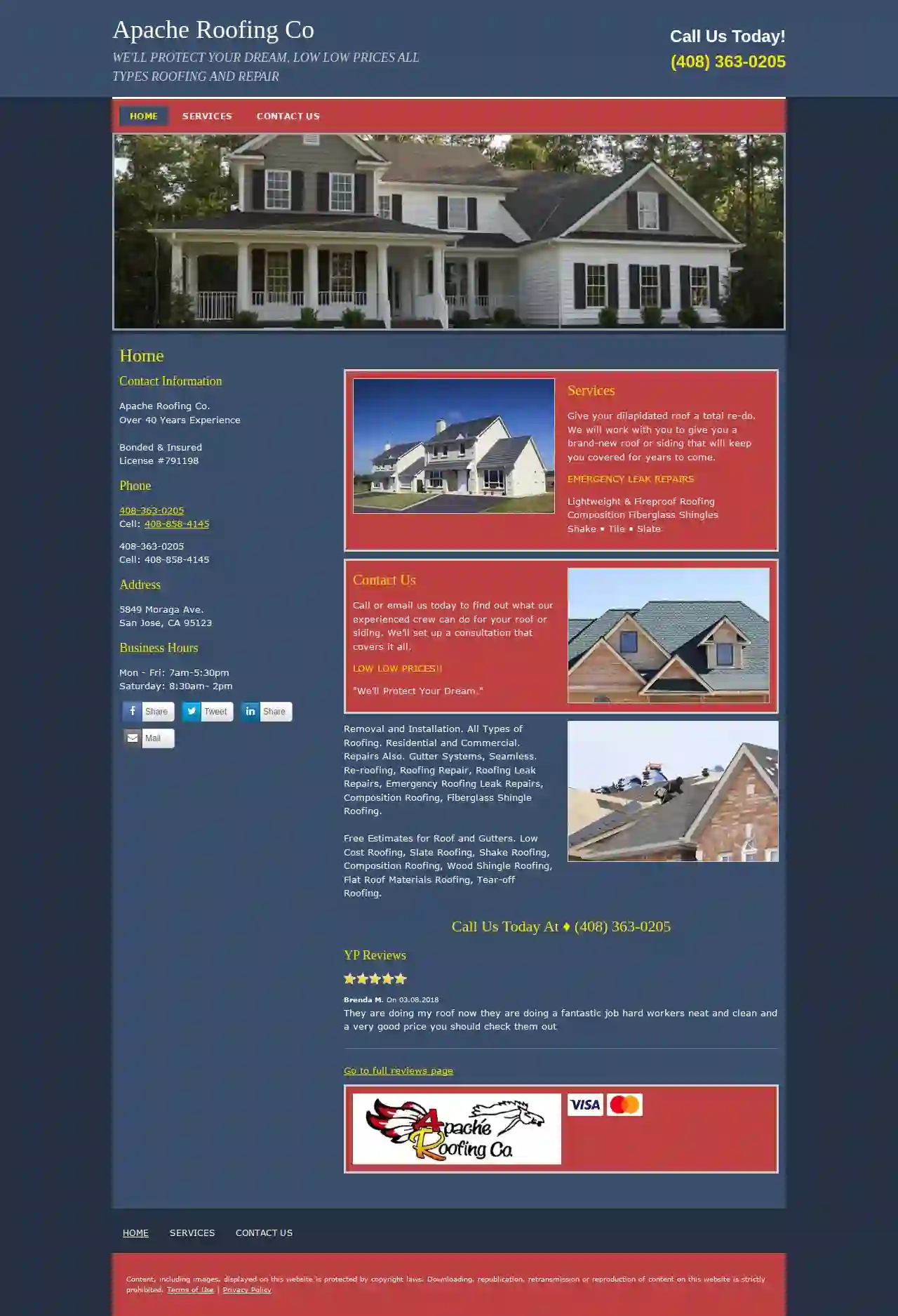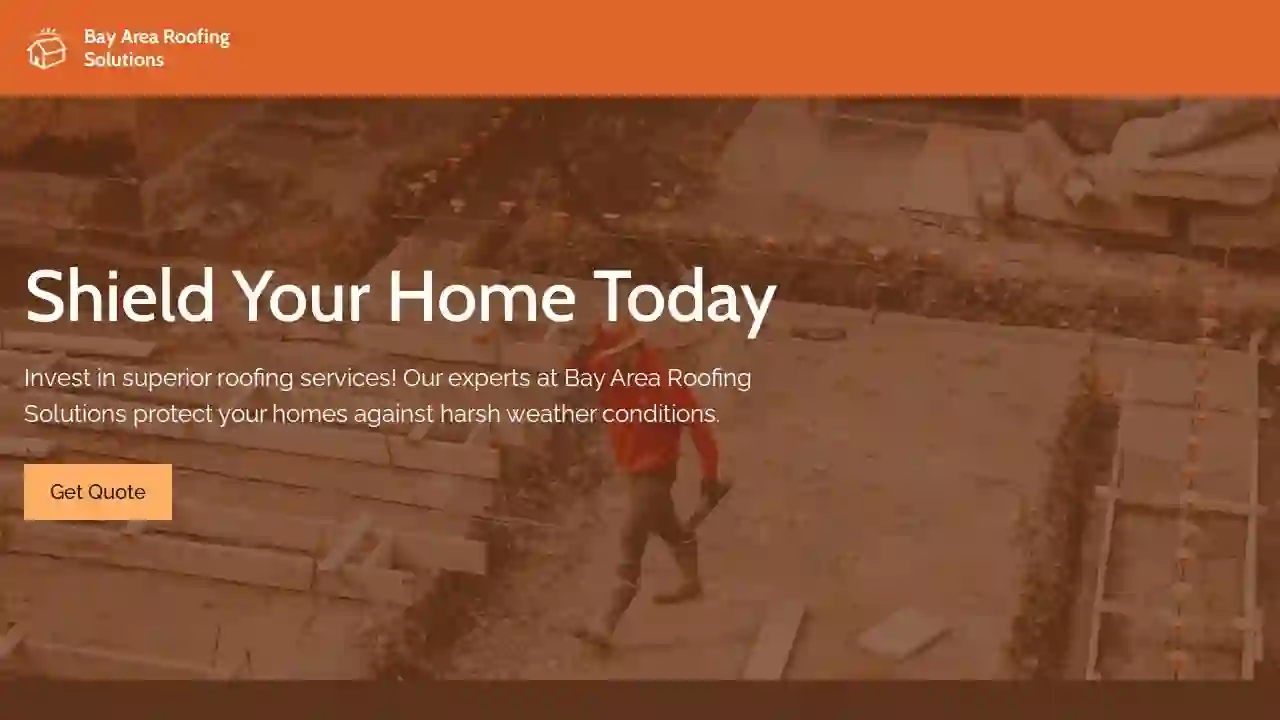Emergency Roof Repair San Jose
Find Roof Repair Emergency in San Jose
Receive up to 3 Emergency Roof Repair quotes for your project today! Compare profiles, reviews, accreditations, portfolio, etc... and choose the best service.

Jim Hageman Roofing
4.819 reviewsSanta Clara, USWhen it comes to your roof, we've got you covered. Top Rated Roofing Service. At Jim Hageman Roofing, LLC, we offer top-tier roofing contractor services in Santa Clara, Alameda, & San Mateo County, California. We work diligently to meet the needs of our customers while adhering to industry quality standards. We are committed to completing our work with diligence and extreme attention to detail. Jim Hageman Roofing, LLC is your best choice when it comes to composition asphalt shingle roofing, presidential composition roofing, torch down roofing, tile roofing, flat roofing, roof installations, roof repairs, gutter installation & repair and more. Contact us today, our team is waiting to assist you! With over 35 years of experience, we truly value the state of all our clients' homes. That's why we are 100% licensed and insured to protect your safety and ours! We are a licensed family owned business proudly serving the South Bay community for over 30+ years. We are honest, upfront and have established a solid reputation by providing our customers with excellent craftsmanship.
- Services
- Why Us?
- Our Team
- Testimonials
- Gallery
Get Quote
Allied Roofing
57 reviews580 Continental Dr., San Jose, 95111, USAllied Roofing and Contracting is a company dedicated to building strong relationships with each customer, providing top-quality workmanship for every project, big or small. Since our humble beginnings in 1975 in Longmont, CO, we've expanded to serve Denver, CO, and San Jose, CA. Our installers are committed to excellence, ensuring every interaction with an Allied associate is marked by honesty, dependability, kindness, objectivity, respect, and wisdom. For larger projects, we work with licensed contractors. We're committed to using the finest roofing and building materials and providing the most trusted service in the industry. We research all available materials for each job to ensure our clients get the best return on their investment. Allied is your one-stop shop for all your contracting needs, from A to Z. Estimates are free. Contact us today and rest assured your residential or commercial building project will be completed by the best.
- Services
- Why Us?
- Accreditations
- Gallery
Get Quote
Statewide Roofing Inc
4.512 reviewsSuite C, 1742 Stone Ave, San Jose, 95125, USStatewide Roofing is a full-service commercial roofing contractor focused on the San Francisco Bay Area and serving many locations throughout California. Founded in 2002 by Allan Courtney, Kyle Hypes, and Kathy Robertson, Statewide Roofing was formed around the vision of delivering high-quality and cost-effective roofing solutions to businesses in the greater San Jose area. With more than 100 years of combined roofing experience, our founders understood delivering on this promise meant assembling a team of highly skilled and experienced roofers as well as forming a culture that takes pride in delivering premium workmanship and top-level customer service. Over 20 years later, Statewide Roofing has grown with Silicon Valley to manage a portfolio of customers that includes many of the who's who of businesses in the Bay Area. Our footprint and expertise have grown as well. We now service the entire Bay Area and the majority of Northern California, and our roofing services have developed with technology to include a complete range of roofing and waterproofing applications. In parallel to this growth, Statewide Roofing has made sure to live by the vision of its founders and continues to deliver high-quality roofing solutions with a customer experience that is unmatched in our industry. We pride ourselves on our work, deliver solutions that meet your needs, and provide the top-notch customer experience you deserve. We look forward to working with you, no matter how big or how small your needs.
- Services
- Why Us?
- Accreditations
- Gallery
Get Quote
Tip Top Roofing
Tip Top Roofing, Campbell, CA, 95008, USTip Top Roofing specializes in all types of roofing installations, replacements, and gutter services. As roofing experts, our staff knows the best techniques, tools and materials to use for your roof to keep your home protected. Whether you are looking to replace your existing roofing or invest in a new gutter installation service, we will help you receive the best results at an affordable price. With over 20 years of experience, we are licensed, insured and bonded and we only hire employees who are dedicated, knowledgeable and skilled. We respect your living space as if it was our own, and our roofers never place any heavy equipment in the driveway or your home. The grounds are meticulously cleaned and magnetically swept after each task. Our aim is to leave your property cleaner than we found it.
- Services
- Why Us?
- Testimonials
- Gallery
Get Quote
Roof Maxx
4.47 reviewsSan Jose, USRoof Maxx is a safe, easy, proven and affordable alternative to a complicated, expensive and life-disrupting asphalt roof replacement. When you restore a roof with Roof Maxx, you help find a forever home for a child waiting in foster care. Proud Partners With The Dave Thomas Foundation for Adoption. Roof Maxx Protects Your Entire Home From roof to foundation, the damage caused by an old leaky roof can be devastating for your home. With Roof Maxx, you get new roof protection without the high cost and hassles of a life-disrupting replacement.
- Services
- Why Us?
- Testimonials
- Gallery
Get Quote
Keith Roofing Co., Inc.
4.25 reviewsSan Jose, USKeith Roofing Company is a State Licensed Contractor in San Jose, CA serving residential, commercial and industrial customers throughout Santa Clara County. We offer a wide variety of roofing services for jobs small and large, from roof installations to roof inspections to roof coatings. Our highly qualified roofers are dedicated to providing top quality services using materials from leading brands including CertainTeed, Owens Corning, Carlisle Syntec Systems, Eaglelite, Westlake Tile and other leading brands. Call us day or night for emergency service at 408-295-8616. As an Essential Business, We Are Still Open! San Jose CA Roofing Contractor Offers residential, commercial, and industrial roofing services in San Jose and the Greater Bay Area. Call 408-295-8616.
- Services
- Why Us?
- Gallery
Get Quote
All About Roofing Repair & Installation
520 reviews2548 Seaboard Ave, San Jose, CA, 95131, USAll About Roofing is a leading roofing company that combines true craftsmanship with an unmatched level of professionalism and affordability. We've earned a reputation as one of the area's best roofing companies in San Jose and Orange County. With over 25 years of industry experience, we excel in roof repairs, replacements, and gutter installations. Our skilled technicians ensure high-quality service, from shingle replacements to full re-roofing projects. We prioritize trust, instilling an unparalleled work ethic in every team member. Choosing the right roofing company is crucial. Look for fully licensed and insured companies like us (CSLB License #1060380). We guarantee customer satisfaction, focusing on professional, skilled, and timely services. Your home is a significant investment, and we aim to provide top-of-the-line roofs within your budget.
- Services
- Why Us?
- Accreditations
- Our Team
- Testimonials
- Gallery
Get Quote
Apache Roofing Co
54 reviews5849 Moraga Ave., San Jose, 95123, USApache Roofing Co. is a family-owned and operated business with over 40 years of experience in the roofing industry. We are fully bonded and insured, and our license number is 791198. We offer a wide range of roofing services, including removal and installation, repairs, and gutter systems. We also offer free estimates for roof and gutter services. Our team of experienced professionals is dedicated to providing our customers with high-quality workmanship and exceptional customer service. We are committed to protecting your dream home with our low low prices and all types of roofing solutions.
- Services
- Why Us?
- Testimonials
- Gallery
Get Quote
Bay Area Roofing Solutions
51 reviewsSan Jose, CA, 123 Main St, 95112, USBay Area Roofing Solutions is your trusted partner for all your roofing needs in San Jose, CA. With a proven track record of excellence, we specialize in providing top-quality roofing solutions for residential and commercial properties. Our team of skilled professionals is dedicated to delivering exceptional craftsmanship, using the finest materials to ensure long-lasting durability and aesthetic appeal.
- Services
- Why Us?
- Gallery
Get Quote
IQV Construction & Roofing
4.98 reviews877 Chestnut Street, San Jose, 95110, USImproving CommunitiesWe specialize in complex reconstruction projects for Bay Area HOA's, multifamily property owners, and property and community management firms. Rebuilding Better NeighborhoodsIQV delivers value to our clients through the highest quality construction experiences. Rebuilding Better CommunitiesJoin our ever growing list of satisfied clients and business partners. Get In Touch IQV Construction & Roofing specializes in: Exterior Decay Repair We remove and replace wood decay in structures such as siding, framing, beams, decks, balconies, and stair systems. Interior Renovations Our focus is on quality craftsmanship with each interior renovation, from leasing offices, clubhouses, kitchens, baths, and more. Roofing IQV is committed towards providing the best roofing solutions, through quality re-roof installations and service. Proudly Serving Northern California and Bay Area Call Us Now! (408) 638-5500 Contact Us Why IQVIQV has a passion for serving our clients and supporting a culture that focuses on professional integrity and improving our communities.
- Services
- Why Us?
- Testimonials
- Gallery
Get Quote
Over 17,196+ Roofers onboarded
Our roofing experts operate in San Jose & beyond!
Roofyng.com has curated and vetted the Best Roofing Businesses near San Jose. Find the most reliable pro today.
Emergency Roof Repair FAQs
- Missing or Damaged Shingles: Animals might chew, scratch, or dislodge shingles to create entry points.
- Holes or Gaps: Check for holes or gaps in the roof, soffit, or fascia, indicating animal entry or nesting.
- Droppings or Nesting Materials: Finding animal droppings or nesting materials in your attic or on the roof suggests animal activity.
- Chewed Wires or Insulation: Animals might chew on wiring or insulation, posing a fire hazard.
- Scratching or Gnawing Sounds: Hearing scratching or gnawing sounds coming from your attic, especially at night, indicates possible animal intrusion.
- Active leaks during a storm: Water pouring into your home.
- Significant roof damage from a fallen tree or debris.
- Missing or severely damaged shingles after high winds.
- A partial or complete roof collapse.
- Regular Maintenance: Inspect your roof regularly for loose or missing shingles, damaged flashing, and clogged gutters. Address any issues promptly.
- Trim Overhanging Branches: Keep trees around your property trimmed to prevent branches from falling on your roof during a storm.
- Reinforce Vulnerable Areas: Reinforce vulnerable areas of your roof, like gables and eaves, with hurricane straps or other structural reinforcements, especially in high-wind-prone regions.
- Install Impact-Resistant Shingles: Consider using impact-resistant shingles, which are designed to withstand hail impacts better than standard shingles.
- Choose a Wind-Resistant Roofing System: When installing a new roof, select a roofing system with a high wind rating to provide better protection against strong winds.
- Apply Roofing Cement: If the leak is due to a small crack or hole in a shingle, apply roofing cement to seal the gap. Roofing cement is a waterproof sealant that can provide a temporary fix.
- Use Sealant Tape: Sealant tape is a waterproof tape that can be applied over cracks or gaps in flashing or other roof components. It provides a temporary barrier against water intrusion.
- Install a Tarp: Cover the affected area with a heavy-duty tarp, secured with nails or weights, to create a temporary waterproof barrier. Ensure the tarp extends beyond the leak area to effectively direct water away.
- Divert Water: If the leak is near a gutter or downspout, you might be able to temporarily divert water away from the leak point by adjusting the gutter or using a temporary extension.
What are the signs of roof damage from animals?
What is considered an emergency roof repair?
How can I protect my roof from storm damage?
What are some temporary measures I can take to stop a roof leak?
What are the signs of roof damage from animals?
- Missing or Damaged Shingles: Animals might chew, scratch, or dislodge shingles to create entry points.
- Holes or Gaps: Check for holes or gaps in the roof, soffit, or fascia, indicating animal entry or nesting.
- Droppings or Nesting Materials: Finding animal droppings or nesting materials in your attic or on the roof suggests animal activity.
- Chewed Wires or Insulation: Animals might chew on wiring or insulation, posing a fire hazard.
- Scratching or Gnawing Sounds: Hearing scratching or gnawing sounds coming from your attic, especially at night, indicates possible animal intrusion.
What is considered an emergency roof repair?
- Active leaks during a storm: Water pouring into your home.
- Significant roof damage from a fallen tree or debris.
- Missing or severely damaged shingles after high winds.
- A partial or complete roof collapse.
How can I protect my roof from storm damage?
- Regular Maintenance: Inspect your roof regularly for loose or missing shingles, damaged flashing, and clogged gutters. Address any issues promptly.
- Trim Overhanging Branches: Keep trees around your property trimmed to prevent branches from falling on your roof during a storm.
- Reinforce Vulnerable Areas: Reinforce vulnerable areas of your roof, like gables and eaves, with hurricane straps or other structural reinforcements, especially in high-wind-prone regions.
- Install Impact-Resistant Shingles: Consider using impact-resistant shingles, which are designed to withstand hail impacts better than standard shingles.
- Choose a Wind-Resistant Roofing System: When installing a new roof, select a roofing system with a high wind rating to provide better protection against strong winds.
What are some temporary measures I can take to stop a roof leak?
- Apply Roofing Cement: If the leak is due to a small crack or hole in a shingle, apply roofing cement to seal the gap. Roofing cement is a waterproof sealant that can provide a temporary fix.
- Use Sealant Tape: Sealant tape is a waterproof tape that can be applied over cracks or gaps in flashing or other roof components. It provides a temporary barrier against water intrusion.
- Install a Tarp: Cover the affected area with a heavy-duty tarp, secured with nails or weights, to create a temporary waterproof barrier. Ensure the tarp extends beyond the leak area to effectively direct water away.
- Divert Water: If the leak is near a gutter or downspout, you might be able to temporarily divert water away from the leak point by adjusting the gutter or using a temporary extension.